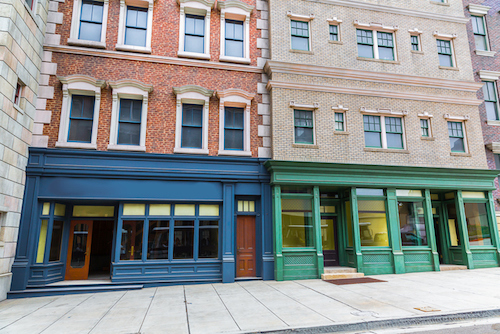Roundtable: Discussing Facade Maintenance, Pt. 1
FRIDAY, APRIL 27, 2018
For this roundtable discussion, six industry professionals took part in a call to delve into the topic of facade maintenance, including challenges; misconceptions; and what architects, specifiers, building owners and facility managers need to know.

 |
| © iStock.com / Nomadsoul1 |
|
For this roundtable discussion, six industry professionals took part in a call to delve into the topic of facade maintenance, including challenges; misconceptions; and what architects, specifiers, building owners and facility managers need to know. |
Participants included: Danny Carillo, business development manager, Graco Inc.; David de Sola, founding principal, 3iVE LLC; Steven James, president, Digital Facilities Corp.; Tom Tipps, national accounts manager, KEIM Mineral Coatings of America Inc.; Brian Trimble, director of industry development and technical services, International Masonry Institute; and Corey Zussman, director of quality management, Pepper Construction.
The conversation, which will appear in two segments, was limited to an hour, and has been edited for length and clarity. The first segment is as follows:
Durability + Design: In your experience, what are the biggest challenges that exist in terms of facade maintenance?
 |
Tipps: From my point of view and what I see out in the field when I’m working, generally with architects, I have learned that the biggest problem we run into is deferred maintenance. Most people might even agree with that. Deferred maintenance is something that occurs everywhere. We do it on our own homes, [and] we see it on large buildings and it’s not intentional. I think that the day-to-day running of business and the change and turnover of employees creates a condition where things are overlooked. It also falls down to training for the people that are working in buildings. Do they see with their eyes what’s happening with the building? Most people never notice many of the things that you point out when you do an inspection. So, I feel like probably one of the greatest challenges is awareness—most of the folks I run into are often surprised with the assessments that I make. If I’m looking around the building and see something, I’m a little surprised that they haven’t noticed.
James: I would agree; this is a major area in the industry. People assume that once they build the building, or when someone like David commissions the building for them, they assume that it’s going to be standing there forever. There are a lot of systems in buildings. To go back to what Tom said, there’s so much information, so much knowledge that has to be gathered around a modern commercial building with a modern facade. It’s almost impossible for the building owner to keep track of that and, therefore, a lot of maintenance items get missed.
 |
De Sola: I agree entirely with everything that’s been said on that, and there’s a couple of things I’d stress. First, new buildings, at least on the commercial side—especially in places like the northeast and colder climates or those that are having to adopt these more stringent codes—have a lot of their performance layers in non-maintainable areas, so you’re talking about the insulation, the water protection, the vapor protection and the air protection all being behind the facade. If they fail, there’s no way to get at them. It’s not common to think of this unseen part of the facade as part of the facade but it really is, and, in many ways, it’s the most important.
The second is more on what I see on the outside of buildings, on the renovations that get done. Sometimes a masonry facade will last for 50 years and won’t even need repointing for that period of time, but the sealant joints that go around the windows are maybe only good for 10 to 15 years. Those are often the first to fail, and they don’t get any attention. Then you get some significant water damage and even deal with things like ice dams and/or freeze-thaw conditions, where things can pop off the building and cause major, catastrophic kinds of failures that can hurt people—it’s all part of the challenges that exist with current facades.
Zussman: I want to reiterate that access is one of the biggest concerns and issues that we have, as well as not spending enough time on compatibility of materials. When we correct or we maintain the building, we’re not double-checking; we’re not getting the right information to verify that the new materials we’re putting on the building are compatible with what’s on the building now.
Trimble: The one thing that I’d like to add is that there are so many changes occurring with new materials, and with ways of doing things, that it’s a constant struggle to keep up to date. And again, using people who understand the materials, understand the processes is very important. Using untrained people is sometimes to our detriment. I think having more trained and educated people would certainly help things out in terms of facade maintenance.
 |
Carillo: We’ve gone to third-party inspectors industry-wide in the EIFS industry. I’m on EIFS jobs all the time—some are union jobs, some are nonunion jobs, large jobs, small jobs—but I’ve been on jobs where the inspector is right there and these guys are applying it in a substandard fashion and they’re just letting it go. I feel like it’s because they may be book smart but they’re not industry smart; they don’t know all the nuances that go into an EIFS and that in five to 10 years this thing is going to fail because of what they’re doing today. So, I think we need to address this and make sure things are being installed in the proper fashion.
D+D: That sounds like a good transition point to turn our attention to what you think architects and specifiers need to keep in mind in regard to material selection and facade maintenance.
 |
Trimble: It would be nice for designers to consider redundancy when designing a facade. As was mentioned, sometimes we have a cladding, which is hiding all the very important and critical aspects of keeping the water out or keeping the air out and so on. Having a little bit of redundancy would be nice to protect those areas; if something does fail, we have something else. I mean, sealants don’t last forever, although everyone certainly thinks they do, so having that secondary mechanism would help protect the envelope better. Designers don’t often consider that. We’re trying to be so efficient with our materials that we don’t consider what happens when things go wrong.
De Sola: I think that’s a great point. Putting on a sealant, which is going to get UV exposure and weather exposure, and expecting that’s going to be a healthy part of the system for the duration is really naïve at this point. I think there are a lot materials, which are far superior, such as the transition membranes made of silicone and other things that would be bridging—neoprene, heavy bituthane membranes, for example—are much more appropriate for movement joints.
Far too often I’m seeing things like peel-and-stick being glazed into the window, which is an incompatible material with the glazing of the window, and it’s not meant to bridge materials or be unsupported—but you have really good and for-the-purpose silicone membranes, which are going to be stable for a real long time and can adjust to movement. So, I’m always advocating for those kinds of materials, and if someone insists on putting sealant in to connect the window—for expense or any other reason—I’ll always advocate for having a performance sealant buried beneath what I call a sacrificial exterior sealant so that you can kind of let that one go and you’d still be protected. So, the redundancy is a great point.
Tipps: I agree with everything we’re saying here because redundant systems are very important. When the facade protections—whether it be paint or stucco or whatever—we have on the building eventually weather away, it’s important to have some kind of protection behind to ensure the building remains dry until a budget is found, until they can mobilize and make the right repairs. I find that more often, I think, on tall buildings than I do on the smaller ones, just because when they go through a cycle—you know how expensive that is—it seems like many of the items that normally expire sooner they let go past that expiration date in order to take care of the more major items. I don’t know if you all run into the same situations or not.
 |
Zussman: Yes, that’s an excellent point. The durability of materials should be somewhat compatible, and, if they’re not, having a redundancy is critical.
De Sola: Just the point that sometimes big problems are easier than the little problems—but the little problems, if left neglected, can cause enormous problems. It’s easy to fix the thing when it’s obvious and its huge, but watching a little trickle change every year, that seems to be the harder thing when there’s no budget and there’s nobody to perform the task.
James: I’m gonna agree with that wholeheartedly and maybe transition slightly over to the building owner. When you’re building large buildings, there’s a lot to keep track of. The ideal system is one that has some what you call the “belt and suspenders,” because you’re not going to get a lot of eyes on it all the time. In a perfect world, you’d have periodic maintenance, but I would like to encourage the building owners to look at the building starting from commissioning. Usually within five years, there’s some activity on the building facade that needs attention because of workmanship or some defect in the material application. The building owner needs to have some system in place where he or she can document the as-built systems and be able to address some of the observed conditions that are going to change. As has been pointed out, sealants are going to fail earlier than the primary parts of the facade, so keep a system in place where you can address some of the small problems.
The second segment of this discussion will appear in next Friday’s Durability + Design News. Check back for the panel’s thoughts on what they think building owners should know about facade maintenance, if there is such a thing as a maintenance-free building and their most notable lessons learned.
Tagged categories: Building envelope; Building Envelope; Building facades; Building owners; EIFS; Facade Maintenance Design







